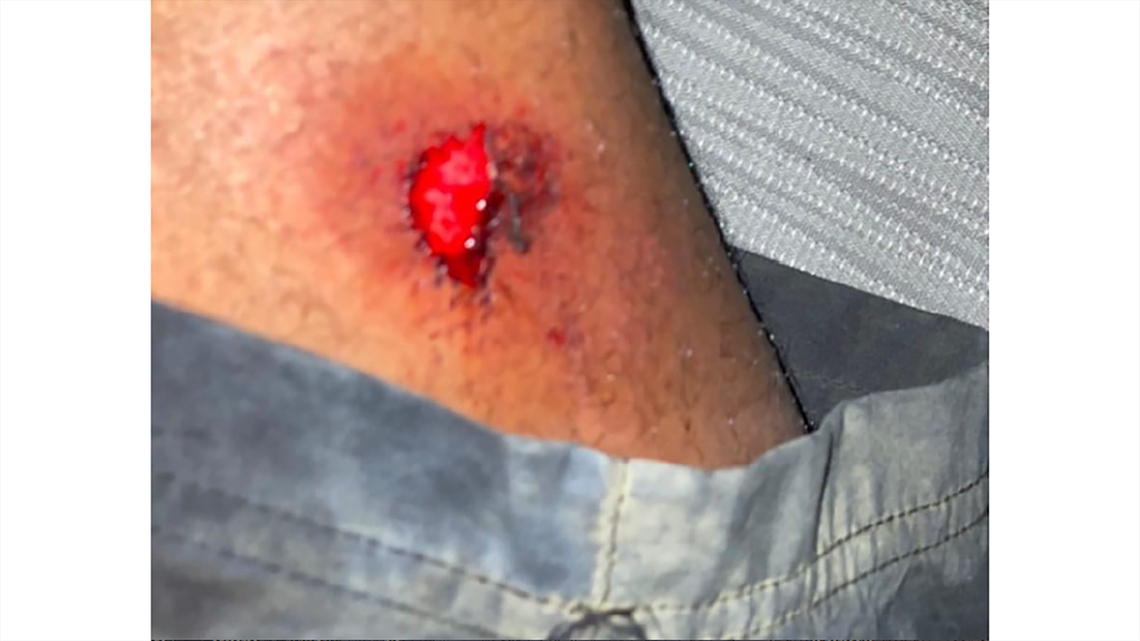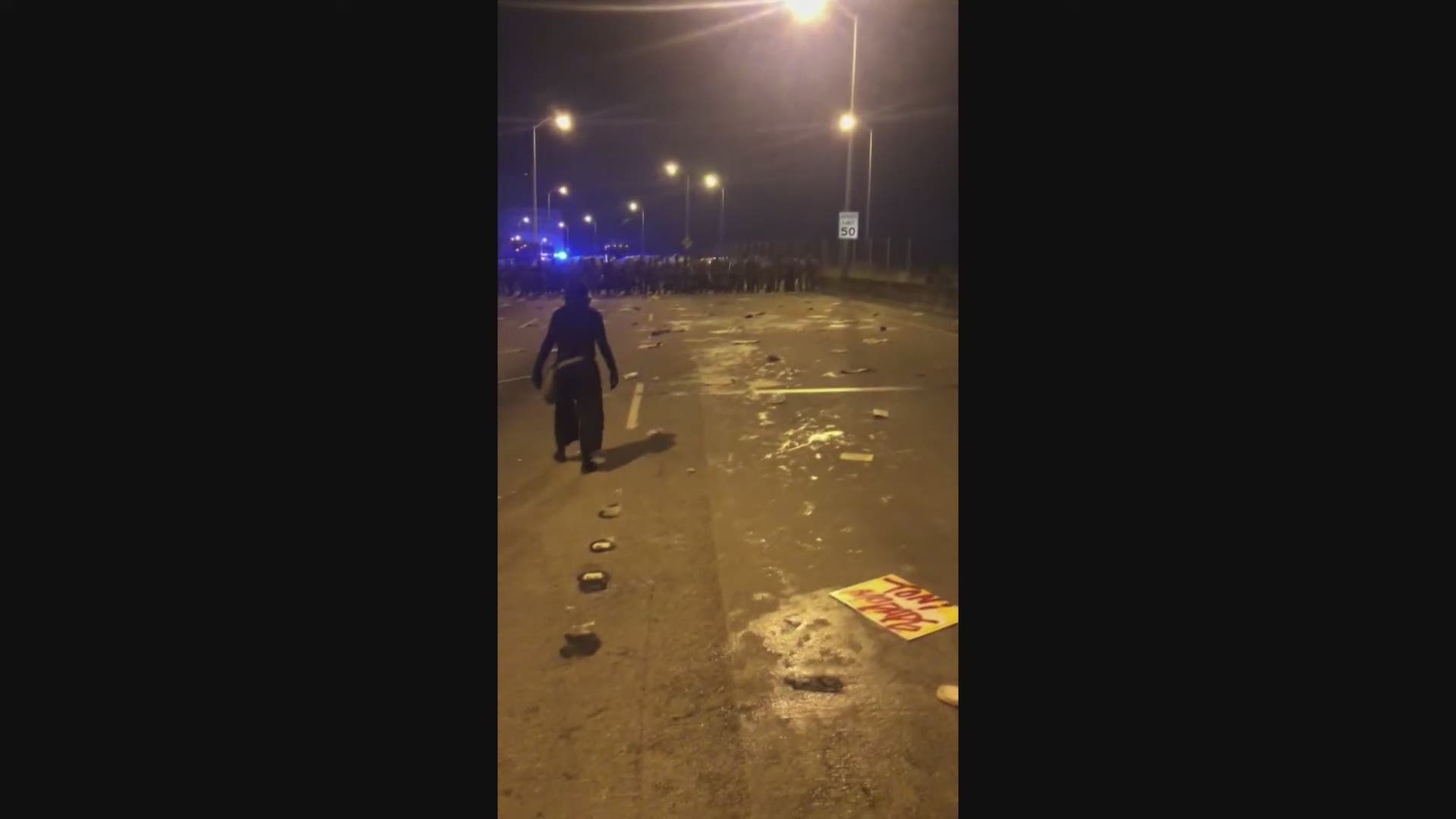NEW ORLEANS — A well-known civil rights attorney on Sunday demanded that the New Orleans Police Department “immediately tell the truth about what weapons were used” to disperse a march on the Crescent City Connection on Wednesday night after she says she was given a dime-sized rubber pellet that hit a demonstrator.
The lawyer, Katie Schwartzmann, said in a letter that the projectile she has does not match the appearance of some other types of projectiles demonstrators said they photographed on the bridge — where NOPD has acknowledged using tear gas, but nothing else. That suggests “multiple types of projectiles were fired,” Schwartzmann said in the missive to the agency’s Public Integrity Bureau as well as two of the department’s outside monitors.


“I am deeply concerned that the material in my possession is only the tip of the iceberg,” Schwartzmann said. “I want to add my voice to the voices of others who have been calling on the NOPD for days to be honest about what happened.”
The department on Sunday did not immediately respond to a request for comment about Schwartzmann’s letter. The NOPD on Wednesday night twice explicitly denied firing projectiles, saying only tear gas was used to disperse the crowd while accusing the crowd — which was protesting racism and police brutality following the murder of George Floyd in Minneapolis — of trying to force their way across the bridge over the Mississippi River while ignoring warnings to turn around. Superintendent Shaun Ferguson did the same Thursday.
Later Thursday, The Times-Picayune | New Orleans Advocate was provided and published a video of a demonstrator that showed some type of projectile zooming past a cellphone camera, prompting someone in the crowd to scream, “They’re shooting rubber bullets!” Ferguson subsequently said the agency would investigate whether any officers fired projectiles and “own it” if they had.
Schwartzmann’s letter on Sunday went as far as to say “ranking staff within” NOPD by now knows the denials are false.


“They have failed to tell the public — and you — the truth,” read the letter, addressed to Public Integrity Bureau Chief Arlinda Westbrook; the city’s Independent Police Monitor, Susan Hutson; and Jonathan Aronie, the lead monitor of a federal reform pact that NOPD has been working to satisfy since 2012. “It defies explanation that the highest levels of our department would mislead the public about what weapons were used by our police force.”
“Perhaps more discouraging is the NOPD public reaction to questions by the public, which was to flatly deny the truth,” Schwartzmann said.
Schwartzmann, the former legal director of Louisiana’s American Civil Liberties Union and now the head of Tulane University’s First Amendment Law Clinic, said she has been given “a rubber bullet that hit someone on Wednesday night.”
She attached three photos of a rubber pellet that is slightly smaller than a quarter. It resembles the pellets that so-called “stinger rounds” fire and scatter from canisters which are the same diameter as the barrel of a weapon which launches tear gas canisters.
It is different from other projectiles that people on the bridge photographed and provided to the newspaper. Those appear to be “sponge grenades” with a diameter of 40mm, the same as that of tear gas canisters.
Other photos included with Schwartzmann’s letter showed a woman’s bruised chest; a bruise on a person’s inner shin; and an open wound encircled by bruising on the inside of a man’s thigh. Citing the attached images, Schwartzmann’s letter asserts: “It is indisputable that NOPD officers unleashed serious and potentially deadly force onto peaceful people seeking to exercise their First Amendment rights.”
NOPD disputes the notion that all of the marchers Wednesday night were peaceful.
Before the police deployed tear gas, marchers who went on the Pontchartrain Expressway close to the CCC had asked NOPD to put down their shields, batons and other riot gear; to walk with them to the other side of the nearby bridge; and then escort them back to show solidarity.
But police declined, and in turn, protesters rejected NOPD’s offer to all kneel in solidarity, as had happened the previous night on Interstate 10 in a scene held up as an example of the agency’s commitment to de-escalation techniques.
Police gave one of the march’s informal leaders a bullhorn to tell the crowd of several hundred to turn around. She said she wouldn’t do it.
Though many marchers were milling well behind a police skirmish line, some vanguard marchers advanced toward the cops, chanting, “Hands up! Don’t shoot!” At least one marcher broke through the line as officers used their shields to back demonstrators. That man was yanked back by an officer not in riot gear.
NOPD then unfurled a canister of what it described as tear gas. The NOPD’s operations manual authorizes the agency’s Special Operations Division — or “SWAT team” — to use a kind of pepper spray commonly referred to as tear gas in the event of demonstrations agency commanders deem have turned violent. Police deployed a second canister before the crowd fully dispersed.
A video published by the newspaper contains the sound of muffled bursts, and it clearly shows one projectile being fired from an angle just above an armored police truck with a tank-like hatch atop it.
Police booked five protesters with illegally crossing a police cordon, which is a misdemeanor. No one was booked with obstruction of a highway, a felony.
In addition to the wounds Schwartzmann mentions in her letter, a woman in the crowd — a schoolteacher — was struck in the head by a smoking tear gas canister, according to numerous people, including her daughter. Medical workers among the protesters stopped to bandage her wounds.
Schwartzmann’s letter said the scene evoked memories of the Gretna police and Jefferson Parish Sheriff’s Office’s controversial decision to block people trying to evacuate flooding from Hurricane Katrina on New Orleans’ east bank by walking across the CCC. One officer fired over evacuees’ heads to get them to turn around.
The letter said the bridge is also “a marker of our unity with our neighbors in Jefferson Parish,” where people have been protesting the Sheriff’s Office’s deadly shooting of Modesto Reyes on May 27.
Schwartzmann was the lead lawyer in a lawsuit that resulted in a court-ordered reform plan under which the Orleans Parish jail operates.
The New Orleans City Council’s Criminal Justice Committee has called a special meeting Thursday to discuss the NOPD’s handling of the CCC demonstration Wednesday.
► Get breaking news from your neighborhood delivered directly to you by downloading the new FREE WWL-TV News app now in the IOS App Store or Google Play.

